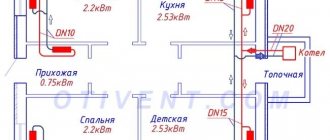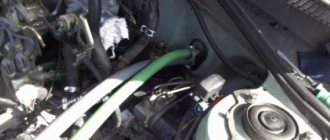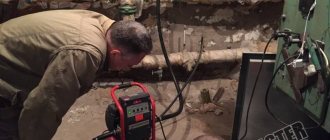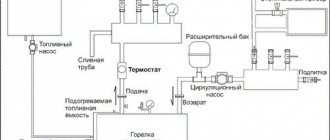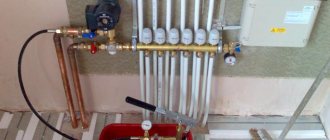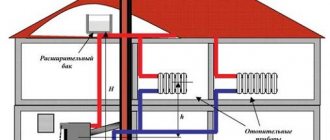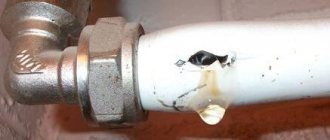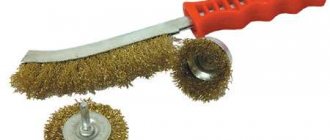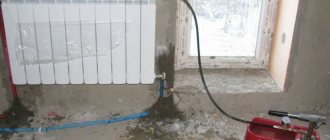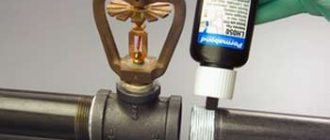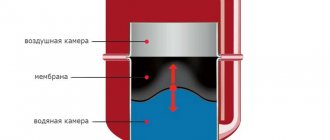Signs of a poor heating system
In some cases, flushing the heating system must be done as soon as possible. The following signs indicate this:
- increasing the amount of fuel consumed to achieve a certain indoor temperature;
- a significant difference in the degree of heating of radiators and pipes through which the coolant is transported through the system;
- uneven heating of radiators. As a rule, the upper part heats up more than the lower part;
- all elements of the system warm up much longer than it was originally;
- the appearance of extraneous noise during operation of the heating boiler.
Insufficient heating of the battery is one of the signs of the need to flush the heating system PHOTO: predgorie-online.ru
Signs that a flush is needed
The following factors may indicate the need for flushing:
- Filters are dirty. A properly assembled heating circuit must contain coarse filters in a transparent flask. In this case, intense contamination of the cartridge indicates the need to flush the heating circuit.
- A signal about the need for flushing can be the low temperature of radiators, heated floor circuits, or their prolonged heating.
- Increased electricity consumption by a heating boiler for heating premises in comparison with the previous period indicates the formation of a layer of scale on its heat exchanger.
Electric pulse cleaning of the heating system: physics and nothing more
To clean the system with electrical impulses, you will need a special device that will generate them. A regular coaxial cable is connected to it. At its opposite end, a charge is formed, which forms a discharge that promotes the separation of scale and salts from the walls of radiators and heating pipes.
The pulses from this device do an excellent job of removing scale inside pipes.
How is electric pulse cleaning performed?
This cleaning does not require any action on the heating system. All you need to do is connect the coaxial cable to the radiator and turn on the device for a certain time (depending on the model). After the end of the cycle, you only need to completely flush the heating circuit, removing any loose scale from it.
This method has no effect on the pipes and radiators themselves, which is also important. In addition, there is no need to dismantle the radiators, and the exfoliated slag can be safely poured into the sewer without fear for the environment.
It is best to get rid of blockages in the early stages
Methods for washing and cleaning pipes
There are two main technologies for flushing the heating system. How to flush the heat exchanger of a gas boiler must be decided on a case-by-case basis, based on the degree of contamination, financial capabilities and the configuration features of the heating system.
- Chemical cleaning. The principle of its operation is based on the dissolution of scale with special chemicals added to the coolant. These can be acids and alkalis. Biological treatment works in a similar way.
- Mechanical flushing. This is the oldest, but quite effective method. It consists of either supplying water under pressure into the main line, or, more effectively, disassembling the system and manually removing a layer of scale and other deposits.
These technologies for washing boilers, pipes and radiators can be applied in practice in several ways:
- cleaning with a water pulsating mixture. This method is based on the use of special equipment that pumps an air-water mixture into the heating system. In this case, the mixture is fed in a pulsating flow, washing away contaminants. This method is convenient because it is fast and efficient, but requires the use of expensive equipment;
- use of biological products . In this case, biologically active preparations are added to the coolant, interacting with many types of contaminants and gradually dissolving them. The use of such drugs is convenient because there is no risk of poisoning and no need to disassemble the system;
For example, an SP-V inhibitor can be used as an additive to the coolant. But before this, it is recommended to completely flush the system. For indiscriminate washing, you can use the chemical cleaning method using SP-OM liquid; it has successfully proven itself on an industrial scale. SP-OM perfectly cleans pipes made of any material and is safe for rubber seals and other non-metallic elements of the system. More details can be found on the manufacturer’s website https://spomcom.ru
- use of pneumatic-hydraulic shock. As in the case of a water pulsating mixture, hydropneumatic flushing requires the use of additional equipment that allows water to be cyclically pumped under high pressure into the system to create a controlled water hammer.
As a rule, this method is used on industrial heating equipment, but is also applicable in private homes.
- cleaning the system with acid . By adding acid to the coolant, scale can be dissolved. Flushing the heat exchanger of a gas boiler with citric acid is very effective and easy to implement. However, it is necessary to understand that the acid will affect both the seals and the elements of the pipeline itself. Accordingly, there is a risk of leaks.
Prevention of slag build-ups inside heating systems
Often homeowners pay attention to the loss of thermal conductivity of the system only when the pipes are already thoroughly clogged. This is the main mistake. The fact is that it is better to carry out preventive flushing once a year using the same vinegar or whey than to clean the pipes several years later using “heavy artillery” and large financial costs. In fact, with preventative cleaning, the owner will lose no more than an hour of his free time, and if the blockage is severe, cleaning may take more than a day or two. There is something to think about.
Below we would like to present to your attention a photo of the most dense plugs in pipes and radiators of heating systems, which will not be so easy to get rid of.
1 of 8
Again, purchasing aggressive chemical compounds and hiring specialists can cost quite a large sum. Buying soda or vinegar is in no way comparable to similar expenses.
Useful tips
If you notice a problem with uneven heating of the radiator, then you should not take decisive action to clean the heating system. Uneven heating of the radiator is not always a sign of contamination of the heating system. In some cases, this may be a consequence of excess air getting into it . In this case, it is necessary to bleed the air from the radiator.
To reduce the physical and time costs of periodic flushing, it is recommended to fill the system with soft water, that is, water with a minimum salt content. The softest water is considered to be rain and snow water, which is as close as possible to distilled water. This water can be prepared at home with your own hands. The recipe for its preparation is simple and does not require large expenses. For every 10 liters you need to dissolve 30-50 grams of soda ash. Before pouring water, the solution must be allowed to settle, and there should be no sediment present in it.
You can prepare an effective solution for flushing the heating system with your own hands. To do this, you need to prepare a solution at the rate of 40 grams of concentrated soda or washing powder per bucket of water. The volume of the prepared solution must correspond to the volume of water removed from the system. As a rule, 15-20 liters is considered sufficient for the heating system of a private house. After heating for a week, the solution must be drained from the system.
To prepare a solution for flushing the system, vinegar, caustic soda, citric acid, or a special product can be used. When flushing the system with a chemical, do not pour the spent solution into the sewer system or onto your garden plot.
The choice of method depends on the materials used to manufacture the system elements, its service life, and the size and length of the pipes. In a private home, it is much easier to carry out the flushing procedure once a year than to deal with a layer of deposits of several millimeters or centimeters after several years.
Various types of pollution
The term "sludge" is often used to describe all the different contaminants in a central heating system. Different types of stains can be caused in different ways, and in some cases require special removal methods.
Sludge is typically a mixture of corrosion caused by products such as rust or magnetite (magnetite is black magnetic corrosion caused by a product produced from steel when corroded in an oxygen-containing environment), hard water scale, and particulate matter caught in into the system until it is filled with water. Sludge may also include microbiological formations - fungus, etc.
The process of scale formation in the heating system
When water is heated, insoluble calcium carbonate is formed, which can then change from suspension to deposits on the internal surfaces of the system (this is often called "limescale").
Scale most often forms in the boiler heat exchanger, and can also accumulate in other parts of the system, often in areas where water circulates more slowly.
Under normal operating conditions, non-bicarbonate or “permanent” hardness salts, such as calcium sulfate, remain in the coolant, but at higher temperatures of the heat exchanger surfaces their solubility quickly decreases and scale may form.
The likelihood of scale formation is greatest in regions where water hardness and bicarbonate alkalinity are high. Scale formation will be most severe if there is a high degree of water loss from the heating circuit, which requires frequent addition of fresh water to the system.
Scale in the heat exchanger will have a negative impact on the heat transfer efficiency of the boiler. Scale also affects the noise level of the heating device. Sooner or later you will have to think about flushing your heating system.
Microbiological contamination
Microbiological organisms range from simple bacteria to fungal and yeast spores. All this can cause problems in the operation of the central heating system.
The most likely location for microbiological growth exists in the expansion tank of an open-vented system. Here, temperature conditions are more favorable for bacterial growth, since there is contact with air. Aerobic bacteria, fungus and mucus that have formed in the tank can penetrate the system with make-up water and gradually clog the heating circuit with sludge. Such debris can cause clogging of the heating system, and can lead to contamination of the boiler heat exchanger.
When is heating flushed?
Let us immediately note that individual heating systems of apartments and country houses very rarely require flushing. Typically, deterioration in heating is associated with other reasons, for example, airing. Let's explain:
- You filled the network with fresh water or antifreeze, expelled the air, and started the boiler.
- After 2-3 weeks, the coolant “breaks in” - a precipitate of salts falls in the heat exchanger, solid particles are captured by a mesh filter. During this period, the mud trap needs to be cleaned frequently.
- Since the amount of impurities in the supply water is limited, sedimentation soon stops. There is simply nothing for heat exchangers, pipes and batteries to become clogged with.
That is, a closed system can work quietly without any cleaning. If it is constantly fed from the water supply network, the amount of salt sediment will increase indefinitely. Over the years, the pipelines will become half overgrown, and silt will settle in the radiators.
Options for clogging cast iron batteries depending on the connection method
A similar effect occurs due to the penetration of oxygen into the coolant. Air bubbles cause corrosion of metal pipes and fittings from the inside, forming iron oxide (rust) particles, which are constantly found in the mud pan. The cause may be low-quality plastic pipes without a protective oxygen barrier.
Reference. A “used-in” coolant often takes on a dark or even black color; this is quite normal. Brown water indicates a large amount of rust.
So, in what cases is heating flushing carried out:
- The heating devices, one or more, stopped heating normally. The battery sections heat up unevenly, the bottom remains cold. At the same time, you eliminated all possible faults, but did not get any results.
- For various reasons, you constantly replenish the system with fresh coolant. For example, to operate electrode boilers you need water with a certain amount of salts, which decompose during a chemical reaction. You have to add salt to the coolant or fill in a new one.
- Oxygen penetrates into the network water, the filter often gets clogged (almost every day), the radiators do not heat well, the boiler operates at maximum mode.
The conclusion is simple: flushing is done when there is a problem with the water heating system; no frequency needs to be observed. There is a different approach to the centralized heat supply of multi-apartment residential buildings, where the radiator network is flushed annually, after which pressure testing is performed (in accordance with the requirements of SNiP).
Options for flushing heating systems
Depending on the degree of clogging of the heating system, the volume and length of the circuits, several options for flushing heating systems can be implemented:
- mechanical;
- hydrochemical;
- hydrodynamic;
- hydropneumatic;
- electrohydropulse.
The first two methods do not require sophisticated equipment and can be carried out without problems on your own. The remaining methods require an appropriate level of technical equipment of the performers. Therefore, to implement them, you will either have to rent equipment or invite specialists to perform such work.
The batteries accumulate solid particles that precipitate, which can be removed by mechanical cleaning and further rinsing with clean tap water.
But in any case, there are certain rules for flushing autonomous or centralized heating systems, failure to comply with which will make the procedure ineffective. Next, we’ll talk in detail about each of the cleaning options so that the effect of the procedure is maximum.
Method #1 - mechanical flushing
It is immediately worth noting that such flushing is aimed, first of all, at cleaning the radiators from accumulated dirt, and to a lesser extent from scale on the inner surface of the circuit. The shut-off valves, expansion tank and circulation pump, if it is built into the system, will have to be cleaned separately.
Before you start flushing, you should make sure that the coolant spent in the system, during the cleaning process, goes out in a minimum amount. The procedure must begin by closing the valves that limit the flow of coolant into the circuit.
If the procedure is carried out in a high-rise building, then the valves are usually located in the basement of the house. In a private house, the valves before and after the boiler are closed.
Image galleryPhoto from The inlet and outlet hoses are connected to the section of the heating circuit planned for flushing or the entire system. The hose connected to the heating circuit is discharged into the sewer. If there is a point in the house capable of receiving the full volume, you can take the hose there. It is necessary to wait until all the coolant leaves the circuit being flushed, which will be indicated by the lack of water flow from the hose. It is better to rinse and clean the fittings accessible for dismantling before the flushing procedure. Connecting the hoses to the heating system. Exiting the hose in sewerage Complete drainage of coolant Cleaning of accessible fittings
The next stage is draining the coolant from the circuit. This can be done either through the drain valve, which was originally installed when installing the system. If there is no such tap, then draining is done by unscrewing the plug on the radiator located below or further than all the others.
It is most convenient to discharge the coolant through a hose connected to the drain tap and discharged into the toilet or other plumbing fixture connected to the sewer. Mechanical cleaning will be more effective if you first dismantle the radiators and clean the heating devices and pipes separately.
When dismantling the system for flushing and cleaning mechanically, it is more convenient to use a universal tool - a pipe wrench
The procedure for dismantling radiators made of different materials is essentially the same. But in any case, you should prepare a container to drain the remaining coolant. To carry out the procedure itself, you will need keys of the appropriate size. To unify the process, it will be useful to have a pipe wrench – a “butt” – in your arsenal.
Depending on how the radiators are connected, the dismantling procedure also differs. In any case, the radiator has an inlet and outlet for coolant. During the dismantling process, we release the union nuts connecting the radiators to the pipes. During the first one or two turns of the nut, you need to be prepared for the fact that the remaining water will begin to ooze out of the connection. We collect it with a rag.
After the leakage of the untwisted “ pipe-radiator ” joint increases, we collect the flowing coolant into a container - a basin, a trough or something similar. At the same time, we carefully ensure that the coolant does not leak to the lower floor.
Heating appliances can be flushed without dismantling the system. Cleaning is carried out using a hydraulic or pneumatic ram, exposure to chemical solvents or electrical impulses.
After dismantling the radiator, we take it either into the yard or into the bathroom. At the same time, we cover the plumbing fixtures from damage to the enamel coating with thick fabric, which you don’t mind throwing away later. Be sure to cover the sink or bathtub drain with a mesh to prevent clogging of the siphon and sewer system.
Mechanical cleaning of the radiator can be done with a cable similar to the one used to clean the sewer. We carry out the same procedure with pipelines. However, for a network with a large number of turns, mechanical flushing will be difficult.
After cleaning the batteries and pipelines is completed, we proceed to rinsing them with water. We wash the radiators there in the bathtub or in the yard, directing a stream of water from a hose inside.
How to prevent contamination of your home heating system
To avoid frequent contamination, blockages of household heating systems and associated cleanings, it is useful to pay attention to the following expert advice:
- The main enemy of steel radiator, bimetallic (they have a steel pipe manifold inside) heat exchangers and heating elements of boilers is oxygen dissolved in water. Pipelines made of any metals do not allow it to pass through, but popular polypropylene is not a barrier for it. Therefore, it is unacceptable to use polypropylene or fiberglass-reinforced heating pipes in the system with any type of steel components. The pipeline must be made of metal-plastic or polypropylene reinforced with aluminum. Cross-linked or heat-resistant polyethylene used in heated floors must have an oxygen-impermeable EVOH shell (copolymer of ethylene and vinyl alcohol).
- Tap water entering the heating boiler feed system must be cleaned of metal salts - when the coolant is heated, they form a deposit in the form of scale. To do this, it is advisable to install a filter with ion exchange resins in the path of the recharge flow.
- Any thermal carrier loses its chemical activity over time due to a decrease in the oxygen concentration in its environment. Therefore, replacing it too frequently is not recommended. For example, ordinary water does not lose its properties and can circulate in the circuit for an indefinitely long period of time, being cleaned using self-washing filters with polypropylene cartridges.
Rice. 12 Selection table for some brands of washing reagents
The simplest and most effective way to independently flush individual heating systems is to use commercially produced chemical solutions. The cleaning procedure can be carried out both with individual elements (radiators, boilers) and with a closed heating circuit if the materials of all components match.
How to flush heating
You can purchase various reagents in the retail chain, offered in 3 types:
- liquid concentrate;
- powder;
- ready solution.
The concentrate and powder must be diluted with water, following the manufacturer's instructions. As a rule, before cooking, the water is heated to 40...60 °C. The finished liquid for flushing the heating system is poured into a barrel and disposed of after use.
We will give a number of recommendations on the best way to flush heating pipes:
- The active ingredients of the reagent should not damage the elements of your system, for example, interact with aluminum radiators. Choose chemistry taking into account the materials from which metal parts and fittings are made.
- It is better to buy washing with various useful additives - corrosion inhibitors, biodegrading additives.
- Based on their composition, the reagents are divided into 2 groups – acidic and alkaline. The former act faster, but are considered more aggressive towards equipment and hazardous to health. It is better to choose an alkaline concentrate.
We do not recommend using various folk remedies for washing, in particular citric acid. Firstly, it is only effective against scale, which is found only in boiler heat exchangers. Secondly, a high concentration of the acid solution is required; with a large amount of water it cannot be achieved.
Note. Factory-made reagents can be discharged into the general sewer system; no additional treatment is required.
How to flush the system - 3 available methods
Without the use of specialized equipment, you can do the washing in the following ways:
- local cleaning of radiators;
- simple flushing of pipes and heating appliances with tap water;
- chemical (otherwise known as hydrochemical) cleaning of heating pipelines.
Reference. Centralized heating networks of apartment buildings are flushed using the hydropneumatic method. A powerful compressor is connected to the elevator unit located in the heating point. A mixture of water and air is pumped through the radiators and pipes of all apartments, tearing off particles of solid deposits, and even more so silt. The dirt is then dumped into the sewer.
Compressor and pumping unit for hydropneumatic scale removal
Most homeowners do not have compressor units. In addition, you will need a mixing chamber and experience in performing such activities, otherwise you risk breaking the tightness of the joints. This means that the hydropneumatic method is of little use for self-flushing the system. We recommend starting by cleaning dead batteries.
Radiator cleaning
Identifying a problem battery is quite simple - with the heating running, feel the entire surface with your hand or measure the temperature at different points with a contact/non-contact thermometer, and then compare with the temperature of the supply line. If the sections heat up unevenly, flush the radiator.
In an apartment with central heating, flushing the battery is done as follows:
- We close the shut-off valves on the connections to the heating device. Using a gas wrench, unscrew the top plug with the Mayevsky tap, substitute the basin, and drain part of the coolant.
- Carefully open the tap on the supply line so that the water pressure throws debris out of the radiator. Of course, keep your basin under the stream. When the light coolant flows out, close the valve and put the plug in place.
- Similarly, we repeat the listed manipulations with the bottom plug. After rinsing, tighten the plug, open both taps, and bleed the air.
The described technology is applicable in private houses with automatic heating from the water supply. Just before flushing, it is better to close the valves on the boiler and expansion tank. In other cases, you need to remove the radiator and wash it separately. Connecting a cold water supply hose to the heating network is a risky option; when water is supplied “to a closed valve”, high pressure of 3...6 Bar can break the tightness of the system.
Disconnecting the battery gives one plus - the opportunity to look inside the supply pipes. Having seen deposits there that cover 1/3 or half of the flow area, it is easy to decide on further flushing of all heating pipelines.
In the photo on the left is the removal of sludge from a cast iron radiator, on the right is a horizontal line clogged with sediment
Note. In an open system we have an expansion tank communicating with the atmosphere. If it is not possible to cut off the container with a tap, then it will not be possible to flush the battery through the recharge; the water will trample over the top and begin to drown the house.
Cast iron radiators that have served for more than 10 years will definitely have to be removed and cleaned with some kind of chemical, for example, a caustic soda solution (see the video below). The sediment at the bottom of each section rarely remains liquid and is unlikely to be removed using running water.
Rinsing with running water
The essence of the method is to remove dirt from the system using a large flow of water from the centralized water supply network. Let us immediately note the disadvantage of this option: only liquid sludge and suspended particles traveling along with the coolant can be washed out of pipes and heating appliances. If there are hard deposits in the batteries, it will not be possible to remove them.
How is this hydroflushing done:
- We connect the water supply hose to the make-up fitting. As you know, this pipe is cut into the lower point of the heating return line. We connect the drain hose to a break in the supply line (for example, instead of a circulation pump or at the junction of a faucet) and lead it to the sewer or to an area near the house.
- We clean the mud trap, open all radiator taps and balancing valves.
- The boiler must be isolated from the system using taps and must be washed separately. You should not drive all the dirt through its heat exchangers, especially for double-circuit heat generators.
- Open the water valve, gradually increasing the water flow. As you understand, backwashing begins, that is, the flow moves towards the coolant flow in operating mode.
- When the stream from the drain hose becomes transparent, turn off the water, swap the hoses and flush the heating in the other direction - along the movement of the coolant.
- At the end of the hydraulic cleaning, we refill the system, start the boiler, check the operation of the batteries and do balancing.
An important nuance. It should be understood that flushing is carried out due to the high flow of water through the heating pipelines, and not due to high pressure. You cannot supply water “to a closed valve”, only through an open drain hose. The heating network is not designed for water pressure.
A system with an open tank must first be prepared for flow rinsing. There are 2 options: cut off the expansion tank with a tap or plug the overflow tube. The second method is suitable for tanks without a top cover. If this is not done, the water will overfill the tank and flow out, leaving the area of the system left unwashed.
Chemical cleaning option
This is the most affordable way to thoroughly flush the heating system with your own hands. To implement it you will need:
- vibration pump of a submersible household series, for example, “Rucheek” (or similar);
- a water filter in the form of a flask with 2–3 replaceable cartridges;
- special means for flushing heating networks and radiators;
- container for chemical solution;
- connecting fittings.
The procedure is carried out in 3 stages - preliminary removal of contaminants with running water, then chemical cleaning itself, and finally - final rinsing. The first and third stages are done using the technology described above using water supply; the second stage uses a submersible pump and filter.
How to flush the heating system chemically (stage 2):
- Prepare the washing solution in the barrel according to the instructions on the package. The amount of liquid corresponds to the volume of coolant in the heating network plus the container itself. We wrote how to choose the right chemical at the end of the article.
- Connect the pressure pipe of the pump to the heating supply, immerse the device in the barrel. The filter is placed on the drain line, which is directed into the same container, as shown in the video below.
- Remove the mesh from the standard mud pan and screw the empty plug back on. Otherwise you will have to clean it every 10 minutes.
- Turn on the pump, pump the reagent into the system. Make sure that the solution flows into the barrel from the drain hose and that there are no leaks.
- Flush heating lines until the water stream becomes lighter. Heavily contaminated filter cartridges must be replaced during the cleaning process.
- Wash the remaining chemicals from the radiator network with running water (stage 3).
Reminder. Chemical cleaning should only affect pipes, radiators and heated floors (if necessary). It is not recommended to pump the reagent through the boiler; it is better to clean the unit separately. An open type expansion tank should be cut off from the pipeline network or sealed.
How to flush the system of a country house, watch the video:
What should I fill the system with after flushing?
After you have flushed the heating system and seen how many different deposits there are in it, the issue of choosing a new coolant becomes especially acute. It must contain a minimum of impurities of salts and calcium, microorganisms, as well as air, because all this provokes corrosion and forms plaque on the walls of pipes and radiators.
Filling the heating circuit directly from the water supply is perhaps the worst choice. It is often too hard, that is, with an abundance of salts of various metals. In addition, it carries all the dirt from the pipes of the central water supply, and is so enriched with oxygen that it sometimes turns white - under strong pressure.
To use such water for a heating circuit, at a minimum, it must be allowed to settle thoroughly so that all gases, including chlorine, evaporate, and solid particles settle to the bottom. In addition, it would be good to pass it through a filter.
Having dismantled and washed the radiator clean, you should not pour coolant with impurities into it, otherwise next year you will need to flush it again
Alternatively, you can use rainwater, because it is soft and accessible. However, settling or filtration is still required. In addition, microorganisms often multiply in rainwater, which can have a negative effect on radiators.
A good choice is distilled water, because it contains absolutely no precipitated impurities. In addition, such a choice is not cheap, because the volume of the heating system is not 5-10 liters, but tens of times more.
Oddly enough, one of the best options is the old coolant drained from the system before flushing. All the impurities that could have reacted with the pipes and settled on their walls have already done so, and the air escaped during operation.
It is enough to filter it thoroughly to remove particles washed off from the walls of the pipes, and you can add distilled water to the desired level - in this case you will need very little of it.
Dark coolant is not always unsuitable for reuse - the color only indicates that it has already reacted with the metal
Sometimes it is advised to fill the heating circuit with antifreeze with special anti-rust additives. Indeed, such a coolant does not form a deposit, but it is expensive, and its heat capacity and heat transfer are worse than those of water. As a result, if you fill up with such an expensive coolant, you will also pay more for gas, because the system will not work as efficiently.
Taking this into account, antifreeze can be recommended only if heating is not used constantly in winter, and there is no possibility or desire to drain the coolant every time. You can read more about the different types of coolant for heating systems in this material.
